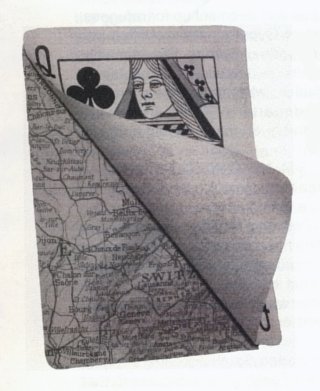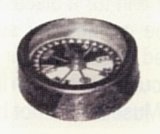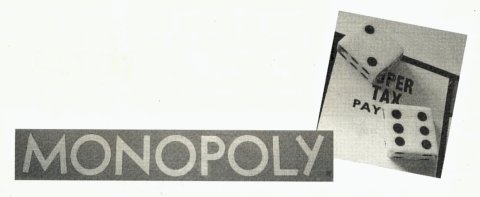

 The South African
The South African
'Games and Pastimes' helped POWs escape
It's amazing what information you can find on the Internet and some of it is even (almost) true! Recently, a friend sent us details of how the well-known game of Monopoly® was used to help prisoners of war (POWs) escape during the Second World War (1939-1945). Intrigued, we investigated further, and found that yes, it's mostly true, and one of the best kept secrets of the war years.
So, how and when was the secret revealed? Last year, an archive of Second World War maps was donated to the British Library Map Library. Some of these maps are now on display to the public there, and they have a fascinating story behind them!
During the War, hundreds of thousands of maps were produced on cloth, tissue paper and other unusual materials. The idea was that a serviceman captured or shot down behind enemy lines should have a map to help him find his way to safety if he escaped or, better still, to evade capture in the first place. A map like this could be concealed in a small place (a cigarette packet or the hollow heel of a flying boot), did not rustle suspiciously if the captive was searched and, preferably, could survive wear and tear and even immersion in water.

At that time, J Waddington Ltd was the only manufacturer in Great Britain that had perfected the technology of printing on silk and other similar materials. Approached by the government, the firm was only too happy to do its bit for the war effort. Waddington's, a UK printing company best known for its board games, was thus involved in a most unusual venture during the Second World War: printing maps on silk, rayon and tissue paper for military use.
The scheme was soon extended to cover those who had already been captured, although a certain amount of ingenuity was required to get the maps into the POW camps. By pure coincidence, Waddington was also the UK Licensee for the popular American board game, Monopoly®.
'Games and Pastimes' was a category of item that qualified for insertion into 'Care Packages', dispatched by the International Red Cross to POWs. Under the strictest of secrecy, in a securely guarded and inaccessible old workshop on the grounds of Waddington's, a group of sworn-to-secrecy employees began mass-producing escape maps, keyed to each region of Germany or Italy where Allied POW camps were located. (Care packages were delivered to prisoners in accordance with that same regional system).
When processed, these maps could be folded into such tiny wads that they would actually fit inside a Monopoly® playing piece. These were made of cast metal at the time. While they were at it, the clever workmen at Waddington's also managed to add a playing token, containing a small magnetic compass, a two-part metal file that could easily be screwed together, and useful amounts of genuine high-denomination German, Italian, and French currency, hidden within the piles of Monopoly® money!

British and American air crews were advised, before taking off on their first mission, how to identify a 'special' Monopoly® set. It would have a tiny red dot, cleverly made to look like an ordinary printing glitch, located in the corner of the 'Free Parking' square on the board. Of the estimated 35 000 Allied POWS who successfully escaped, an estimated one-third were aided in their flight by the rigged Monopoly® sets. Everyone who did so was sworn to secrecy indefinitely, since the British Government might want to use this highly successful ruse in still another, future war. Unused special Monopoly® sets were destroyed at the end of the war.

The story was not de-classified until 2007, when the surviving craftsmen from Waddington's, as well as the firm itself, were finally honoured in a public ceremony. For more details, see the website at http://www.truthorfiction.em/ rumors/m/monopoly-game.htm.
A little more research revealed that the story had been slightly embellished in its online telling. The Intelligence department concerned was not MI5, but MI9, which manufactured various escape aids that they sent clandestinely to prisoner of war camps. Many of these aids were based on the ideas of Christopher Hutton. (His ideas proved so popular that he built himself a secret underground bunker in the middle of a field where he could work in peace. He was obviously a model for 'Q' in the James Bond novels.)
For MI9, Hutton made compasses that were hidden inside pens or tunic buttons. He made use of left-hand threads so that, if the Germans discovered them and the searcher tried to screw them open, they would just tighten. He used silk maps, and disguised them as handkerchiefs, hiding them inside canned goods. For aircrew he designed special boots with detachable leggings so that they could be quickly converted to look like civilian shoes; the hollow heels also contained packets of dried food. Some of the spare uniforms that were sent to POWs could be easily converted into civilian suits.
Officer prisoners inside Colditz Castle requested - and received a complete floor plan of the castle. Hutton also designed an escaper's knife: a strong blade, a screwdriver, three saws, a lockpick, a forcing tool and a wire cutter.
MI9 also used the advice of master stage-magician, Jasper Maskelyne, to design hiding places for escape aids: tools disguised in a cricket bat, a saw blade inside a comb, maps in the backs of books and on playing cards and inside gramophone records, board-game sets that concealed money. Forged German identity cards, ration coupons and travel warrants were also smuggled into POW camps by M19.
MI9 sent the tools in parcels in the name of various, usually non-existent, charity organisations. They dared not use Red Cross parcels, lest they were discovered to have violated the Geneva Convention and such parcels, containing highly important extra food rations and other items, would then be stopped. MI9 relied upon their parcels either not being searched by the German guards or ensuring that the POWs (warned by a message) would be able to remove the contraband before they were searched. In time, the German guards learned to expect and where to find the escape aids.
An interesting book that explains the whole story of silk maps, and a lot more besides about espionage, is Between Silk and Cyanide by Leo Marks (ISBN 0007100396). It was published by Harper Collins in paperback in 2000.
Return to Journal Index OR Society's Home page
South African Military History Society / scribe@samilitaryhistory.org